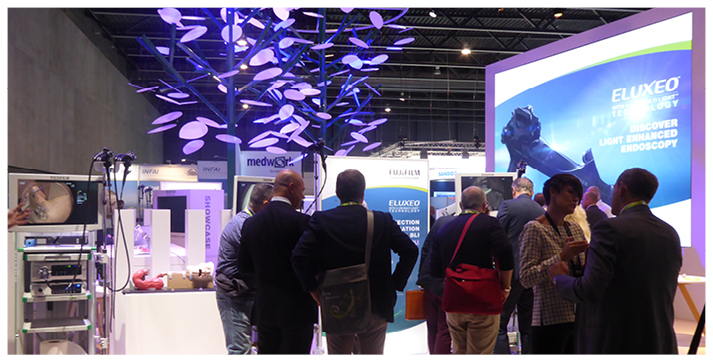The United European Gastroenterology (UEG) Week celebrated its 25th anniversary at this year’s congress, held in Barcelona, Spain, from the 28th October–1st November 2017. Known for embracing both art and culture with its quirky architecture and breathtaking historic monuments, Barcelona played the perfect host for this jubilee meeting.
The venue, the Fira Gran Via Conference Center, is one of the largest and most modern centres in Europe; with a whopping 4,957m2 of the conference centre dedicated to UEG Week. The Fira Gran Via provided the perfect setting for the best networking and educational opportunities for healthcare professionals and researchers alike.
The 25th UEG Week accumulated the highest quality medical research, with participants from 116 different countries. Goals of the congress included raising awareness of digestive health, improving clinical standards, and promoting educational excellence in both clinical and scientific disciplines, and a myriad of topics were presented for all attendees to enjoy. A total of 2,341 abstracts, 1,963 posters, and 378 oral presentations were presented to the 12,810 attendees and 1,316 online spectators: truly impressive figures all-round. Some of the findings presented at the event are summarised in our Congress Review stories below, and include some exciting insights into the benefits of aspirin use, the discovery of reduced risk of gastric cancer following Helicobacter pylori treatment, and results from the latest clinical trials focussing on treatments for pancreatic neuroendocrine tumours and premalignant intraductal pancreatic mucinous tumours.
The opening ceremony began with some traditional Spanish music, setting the scene whilst welcoming all attendees to the fantastic event. UEG President Prof Michael Manns and UEG Scientific Committee Chair Dr Magnus Simrén introduced the week. Dr Simrén expressed his fondness for the annual meeting: “Just like previous years, I am extremely proud of our scientific programme, composed by the hardworking scientific committee, and I am convinced that all of you will find many of our sessions to be of interest to you.” Prof Manns then welcomed experts from within digestive health care and research, each of whom provided presentations of the latest advances in the field, within their special, invited lectures.
Awards were presented to individuals for their dedication and contributions to the field, including the UEG Lifetime Achievement Award, given to Prof Antony Axon, who has dedicated 40 years of his life to clinical gastroenterology. The UEG Research Prize was awarded to Prof Jesper Lagergren, for his paper titled “The aetiology, prevention and treatment of oesophageal cancer”. Finally, the UEG Journal Best Paper Award was presented to Dr Clive H. Wilder-Smith, for his paper titled “Gastro-oesophageal reflux is common in oligo-symptomatic patients with dental erosion: A pH-impedance and endoscopic study.”
Special attention was given to the UEG Week’s 25th anniversary; attendees were given the opportunity to have their photo taken in a photo booth with their friends and colleagues, and to place their signature on an anniversary canvas to signify their attendance and participation. An additional celebration session was organised, at which attendees celebrated the major advances seen in digestive healthcare over the last 25 years. Discussion of these significant milestones was followed by attendees “looking into a crystal ball”, predicting the future of digestive health medicine, the challenges which may arise, and how healthcare professionals and researchers can act to overcome these.
After these debates and discussions, Prof Manns invited all attendees to join him for a “surprise”; he completed his speech summarising the session, and Kool & The Gang’s ‘Celebration’ began to play. Immediately, people gathered, forming an impressive human tower, and the pinnacle person revealed a banner featuring a golden ‘25’ to the delight of the crowd.
All of this and more provided all attendees with a wonderfully unique experience, which will be remembered for years to come. With continued expert opinion and participation, UEG Week really is a terrific event to attend with the aim of improving patient care. Here at EMJ we are already excitedly anticipating what is in store for next year’s UEG Week, to be held in Vienna, Austria.

Long-Term Aspirin Use Reduces Risk of Digestive Cancers
ASPIRIN use over a long period of time has been shown to greatly reduce the incidence of cancers within the digestive tract, as well as in extragastric areas. Data presented at the 25th UEG Week, and reported in a UEG Week press release dated 31st October 2017, show that the number of digestive cancer cases was significantly higher in non-aspirin users than patients who were prescribed the painkiller for ≥6 months. Digestive cancers, including colorectal, gastric, and pancreatic, are responsible for nearly 25.0% of European cancer cases and 30.1% of all cancer-related deaths; therefore, the identification of a preventative therapeutic strategy is highly significant to the gastroenterology field.
A study, led by Prof Kelvin Tsoi, Chinese University of Hong Kong, Hong Kong, China, included >600,000 participants and evaluated the differences in cancer incidences between long-term aspirin users, with an average duration of aspirin prescription of 7.7 years, and those who were not prescribed the drug. As well as a reduction in the incidence of leukaemia, lung, and prostate cancers, there was a significant reduction in the number of cases of digestive cancers, including a vast reduction of 47% in the occurrence of both liver and oesophageal cancers. Gastric, pancreatic, and colorectal cancer incidences also decreased by 38%, 34%, and 24%, respectively, highlighting the substantial benefit of a long-term aspirin prescription to these patients.
Drawing conclusions from the results of prolonged aspirin use, Prof Tsoi commented: “What should be noted is the significance of the results for cancers within the digestive tract, where the reductions in cancer incidence were all very substantial, especially for liver and oesophageal cancer.” The common pain relief medication, often used to treat an array of health conditions, has also recently been associated with protection against adverse cardiovascular events, leading clinicians to re-evaluate its usefulness in the medical community.
Research Calls for Earlier Colorectal Cancer Screening
RISING mortality rates in young adults suggest that colorectal cancer (CRC) screening should begin at the age of 45, according to new research from the Digestive Endoscopy Unit, Clinique de Paris-Bercy, Paris, France, presented at the 25th UEG Week and reported in a UEG Week press release dated 30th October 2017.
A 400% increase in the detection of neoplasia was found in patients aged 45–49 years when compared to patients of a younger age, 40–44 years, after analysis of 6,027 colonoscopies. The 45–49-year-old group also exhibited an 8% increase in neoplasia rates compared to the 50–54-year-old cohort. The mean number of polyps and the detection rate of adenomas was also shown to increase by 95.8% and 95.4%, respectively, in patients aged 40–44 compared to patients aged 45–49 years old, respectively.
CRC is the second leading cause of cancer-related death in Europe, accounting for 215,000 European deaths every year, with 3 in 10 patients aged <55 years old. Screening for CRC has been demonstrated to reduce both incidence and mortality rates; however, inconsistencies in the CRC screening schemes across Europe continue to fuel debate. Currently, the majority of screening programmes commence between 50 and 60 years of age.
Lead author, Dr David Karsenti, Clinique de Paris-Bercy, concludes that this research strongly suggests CRC screening should begin for patients at the age of 45, to facilitate the early detection and removal of polyps that may otherwise become malignant: “These findings demonstrate that it is at 45 years old that a remarkable increase in the colorectal lesions frequency is shown, especially in the detection rate of an early neoplasia.”

Crohn’s Disease Symptoms Improved Within 1 Week of Ustekinumab Infusion
USTEKINUMAB, a drug already approved for the treatment of psoriatic arthritis, has been shown to improve symptoms within just 1 week of intravenous (IV) infusion in patients with moderately to severely active Crohn’s disease, according to data reported in a UEG Week press release dated 30th October 2017.
The exact cause of Crohn’s disease is still unknown.1 It is, however, known to be associated with immune system abnormalities and can be triggered by a genetic predisposition, diet, or environmental factors. Prof William Sandborn, University of California, San Diego, California, USA, commented that “The symptoms of Crohn’s disease can cause significant distress to many patients, which is why it is important to find a treatment that can act rapidly to reduce the impact of the disease. These new results from the UNITI-1 trial are encouraging because they demonstrate that treatment with ustekinumab may begin to reduce patient-reported symptoms of Crohn’s disease within just 1–2 weeks for a number of patients.” There is currently no cure for Crohn’s disease,1 the need for an appropriate, effective, and fast-acting treatment of particularly severe symptoms is imperative to improve quality of life for Crohn’s disease patients.
The UNITI-1 trial studied Crohn’s disease patients who had previously been treated with tumour necrosis factor (TNF)-α antagonists but were either intolerant of the treatment or were unresponsive. Patients were treated with IV ustekinumab (130 mg or ˜6 mg/kg), or placebo. Results were obtained through patient-reported outcomes using the Crohn’s Disease Activity Index (CDAI), in which the following three symptoms were measured: daily frequency of loose stools, abdominal pain, and general wellbeing. CDAI data was collected from Week 0 to allow investigators to correctly identify the exact timeline of symptom improvement.
Results indicated that 19.6% and 17.6% of patients receiving ˜6 mg/kg and 130 mg, respectively, had an improvement in symptoms within 7 days of IV ustekinumab infusion, including ≥50-point improvements in CDAI daily frequency of loose stools and abdominal pain. Significant symptom improvement was subsequently reported in 29.3% (p<0.05) and 31.4% (p<0.01) of those who received ˜6 mg/kg and 130 mg, respectively, 14 days after IV infusion.
The UNITI-2 trail, comprised of patients who had gone through, and failed, conventional therapy but had not failed TNF-α antagonist treatment, were also treated with 130 mg or ˜6 mg/kg IV ustekinumab, or placebo. This group was also found to have significantly higher clinical remission levels at Week 8 compared to placebo (˜6 mg/kg p<0.001; 130 mg p=0.009).
A third trial, IM-UNITI, assessed the maintenance of response in patients who had or had not achieved clinical response 8 weeks after IV ustekinumab infusion from both the UNITI-1 and UNITI-2 trials. Patients were given a subcutaneous maintenance dose of 90 mg ustekinumab at Week 16. Data showed that, of the 219 patients who had not responded to the initial IV infusion, 37.6% and 60.5% from UNITI-1 and UNITI-2, respectively, had responded after the 90 mg subcutaneous maintenance dose.
Response and remission rates for patients receiving the initial IV dose of ˜6 mg/kg in the UNITI-1 trial were 37.8% and 20.9%, respectively. These results increased to 47.4% and 24.1% after the 90 mg 16-week maintenance dose, respectively. Similar increases in response and remission results were also seen in the UNITI-2 trial group receiving ˜6 mg/kg, Week 8 results after IV ustekinumab were 57.9% and 40.7%, respectively, and increased to 73.7% and 55.5%, respectively, after the 90 mg maintenance dose at Week 16.
Adverse reactions were mild and did not require cessation of treatment by any patients, the most common reactions reported were nasopharyngitis and headache. The most serious adverse reaction for ustekinumab reported has been hypersensitivity reactions including anaphylaxis.
These results are particularly encouraging, especially with regard to the rapid effect the IV ustekinumab had on patient symptoms. Relieving some of the most distressing symptoms of Crohn’s disease will no doubt improve the quality of life experienced by Crohn’s disease patients. Currently, the use of ustekinumab for the treatment of Crohn’s disease is approved in 40 countries around the world; however, ustekinumab’s approval for other diseases including sever plaque psoriasis and psoriatic arthritis is more than double that for the treatment on Crohn’s disease. With the help of such promising data from trials such as these, will hopefully accelerate the approval for ustekinumab for the treatment of Crohn’s disease in even more countries.
References
- Crohn’s and Colitis UK. Crohn’s disease. Available at: http://www.crohnsandcolitis.org.uk/about-inflammatory-bowel-disease/crohns-disease. Last accessed: 06 November 2017.

Risk of Gastric Cancer Reduced Following Helicobacter Pylori Treatment
ELIMINATION of the Helicobacter pylori carcinogen from the stomach can reduce the risk of gastric cancer, particularly in older populations, according to study results presented at the opening plenary session of the 25th UEG Week. As the fourth biggest contributor to cancer-related deaths in the world and with a high incidence of diagnosis in patients with an average age of 69 years, the discovery of new preventative treatment modalities for gastric cancer is essential in this vulnerable population.
The data, reported in a UEG Week press release dated 31st October 2017, summarised research on the consequences of antibiotic therapy for H. pylori infection in the elderly. Using a population-based study involving >63,000 people, Prof Wai Keung Leung, Department of Medicine, University of Hong Kong, Queen Mary Hospital, Hong Kong, and his team highlighted the differences between gastric cancer incidence following antibiotic treatment in elderly participants and the general population. Of those patients aged >60 years who received antibiotic treatment for an H. pylori infection, 0.8% developed gastric cancer, compared to 1.1% of age-matched patients from the general population; this observation equated to a 22% reduction in the risk of stomach cancer in elderly patients following eradication of the pathogen.
The H. pylori infection is believed to affect >50% of the world’s population; however, the majority of cases are only diagnosed following onset of symptoms, including gastric irritation. These findings highlight the importance of diagnosing and treating H. pylori infections in older patients at a significant risk of developing gastric cancer because the pathogen, which inhabits the stomach lining, has been shown to contribute to 78% of all global gastric cancer cases.
Commenting on the significance of the study results, Prof Leung described the reduction in gastric cancer incidence in elderly patients as “remarkable” and suggested that treatment of the H. pylori infection is of great value to this population. He added: “Although it has been commonly thought that it may be too late to give H. pylori eradication therapy to older subjects, we can now confidently recommend that the H. pylori infection should be treated in the elderly to help reduce their risk of developing gastric cancer.”
Patients with Obesity Are Not Receiving Adequate Care
OBESE patients are facing a multitude of barriers to successful treatment according to a press release from UEG Week 2017.
The awareness, care, and treatment in obesity management (ACTION) study investigated barriers in obesity management from the perspective of people with obesity, healthcare professionals, and employers nationwide in the USA. The aim of the study was to generate insights to guide collaborative action to improve obesity care, education, and support. In total, 3,000 people with obesity, 600 healthcare professionals, and 150 employers were included in the study.
Obesity can be influenced by physiological, psychological, genetic, and socio-economic factors and requires long-term management. There are many, serious obesity comorbidities including Type 2 diabetes mellitus, heart disease, and some cancers; perhaps the most serious consequence of obesity is a shortened life expectancy when compared to those of a healthy weight.
The ACTION study presented results indicating that very few of the >90 million Americans with obesity are seeking or receiving long-term obesity care. One of the statistics presented showed that, of the 71% of obese people who had spoken to a healthcare professional about their weight in the last 5 years, only 55% reported having a diagnosis of obesity and as little as 24% were offered follow-up care.
Five key barriers to comprehensive obesity care were identified by the ACTION study from obese patients themselves, healthcare professionals, and employers:
- Only a small number of obese people who start weight loss attempts are able to maintain the achieved weight loss
- Most people with obesity believe weight loss is their personal responsibility, preventing them from seeking help, despite obesity now being recognised as a disease
- Almost half of obese people have not been given an obesity diagnosis
- Dialogue about weight management is insufficient with patient-provider and has limited follow-up
- Employer wellness programmes are insufficient at meeting the needs of people with obesity
“The barriers identified in the study highlight opportunities to bridge gaps in understanding to facilitate true collaboration among all stakeholders” commented co-author Dr Angela Golden, Nurse Practitioner, Munds Park, Arizona, USA. “Only by bridging these gaps will obesity care become integral to standard practice, whether in the healthcare or employment setting, and people with obesity will have the care and support needed to effectively treat their obesity.”
“We in the healthcare community must ask why this epidemic is not being diagnosed and treated with the same urgency and focus as any other serious diseases?” said Dr Lee Kaplan, Massachusetts General Hospital, Boston, Massachusetts, USA. Dr Kaplan went on to say “We need to fundamentally rethink obesity so that the public and healthcare community understand more about the biology, chronicity, and overall health impact of this disease. Real progress can be achieved if we can overcome the entrenched mindsets that generate the barriers revealed by this study.”

Colorectal Cancer Diagnosis: The Future is Artificial Intelligence
ARTIFICIAL INTELLIGENCE (AI)-assisted endoscopy has previously demonstrated success in the classification of colorectal polyps in preliminary studies; now, in one of the first prospective trials using this technology, colorectal adenomas have been successfully identified automatically, a UEG Week press release dated 30th October 2017 reported. Speaking about the findings of the trial, the lead study author, Dr Yuichi Mori, Showa University, Yokohama, Japan, announced: “The most remarkable breakthrough with this system is that AI enables real-time optical biopsy of colorectal polyps during colonoscopy, regardless of the endoscopist’s skill.” Dr Mori went on to discuss how being able to distinguish adenomas in real-time would facilitate the complete resection of any neoplastic lesions, and noted: “This is thought to decrease the risk of colorectal cancer and, ultimately, cancer-related death.”
The AI-assisted endocytoscopy diagnostic system uses a 500-fold magnification of a colorectal polyp to assess ˜300 of its features; this is achieved by utilising the narrow-band imaging mode or staining with methylene blue. These features are then compared to >30,000 endocytoscopic images previously learned by the machine; this enables a prediction of polyp pathology in less than a second.
The prospective study involved 250 men and women, all of whom had previously been diagnosed with colorectal polyps, identified through endocytoscopy. A pathological report, produced after the surgical removal of polyps specimens, was used to compare results to the predicted pathology obtained by the AI-assisted system, which analysed a total of 306 polyps in real-time. This comparison showed the system to have a 94% sensitivity, 79% specificity, and 86% accuracy; the positive and negative predictive values were 79% and 93%, respectively.
These findings suggest that use of this system could enable successful removal of cancerous polyps whilst preventing unnecessary removal of polyps that may be non-neoplastic, greatly improving upon the current stagnating clinical procedures. Dr Mori explained: “We believe these results are acceptable for clinical application and our immediate goal is to obtain regulatory approval for the diagnostic system.” The research team are now undertaking trials to achieve this whilst also developing an automatic polyp detection system.
Study Confirms Efficacy of Radiofrequency Treatment for Pancreatic Cancer
ENDOSCOPIC ultrasound (EUS)-guided radiofrequency (RFA) is a feasible treatment for pancreatic neuroendocrine tumour (PNET) and pre-malignant intraductal pancreatic mucinous tumour (IPMN) with a low rate of complications, according to trial results presented at UEG Week 2017.
Following several positive studies of the procedure, a French prospective multicentre trial was initiated by Dr Marc Giovannini, Institut Paoli Calmettes, Marseilles, France, to further test the efficacy of this treatment in pancreatic tumours. The study, which spanned from September 2015–September 2016, included 30 patients who were not operable or who had refused surgery. There were 16 males and 14 females, and the mean age was 55.4 years (range: 49–84 years). Of the 30 patients, 18 had cystic tumours, 17 of whom suffered IPMN, and 12 had a PNET.
For the procedure, the generator setting was 50 watts and an electrical impedance 100 Ohms. Using an 18G needle, with the active part 10 mm in length, the procedure was stopped when white bubbles appeared, or when the impedance reached >100 Ohms. The aim was for the radiofrequency to destroy the cells by heat and for the destruction of the cells to induce an immunomodulation and secretion of the cytokines and lymphocyte killers, causing an anti-tumour effect on the lesion. During his presentation, Dr Giovannini proceeded to show images of lesion ablation in several patients included in the study. In the case of the PNET displayed, the procedure was successfully completed in a matter of seconds; for IPMN, it took a little longer, with two or three shots of radio frequency required to totally ablate the lesion.
At 6-month follow-up of PNET patients, there was a significant response rate of 82% and 7 participants had either complete necrosis or disappearance of the tumour. At 12-month follow-up, no recurrence occurred in these 7 patients. In regard to IPMN, 13 of the 17 patients were followed for at least 6 months; at this stage, the significant response rate was 69%, with 7 participants achieving complete resolutions, 2 having a reduction in tumour diameter of >50%, and 3 with no response. After 12 months, there was one further complete response. There were three complications in the study (1 mild pancreatitis, 1 delayed perforation, 1 pancreatic duct stenosis); the pancreatitis and delayed perforation occurred during the first two procedures. Following changes in the protocol study to address this, the complication rate was reduced to just 3.5%.
“To conclude, EUS-guided treatment with RFA is feasible with a low rate of pancreatitis and complications,” commented Dr Giovannini. “EUS-guided RFA can induce a complete and partial response of a PNET of <2 cm in 75% of cases, and of an IPMN, in 70%. Of course, we need to follow these patients to evaluate the duration and outcome of this response.”








